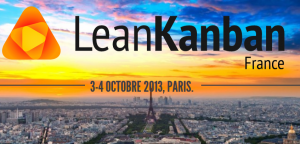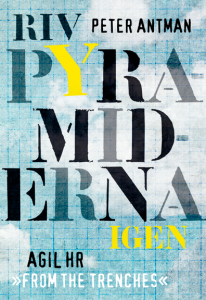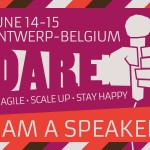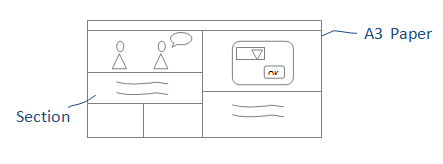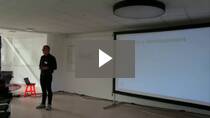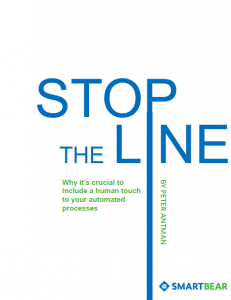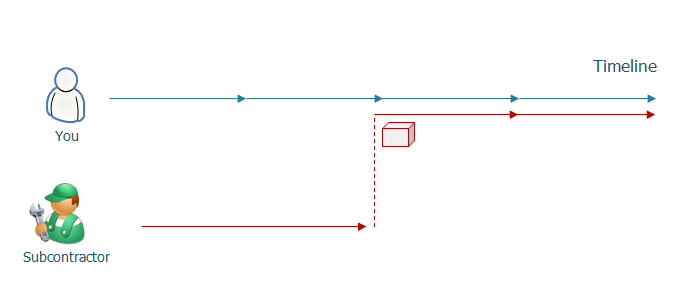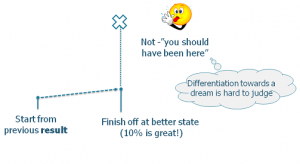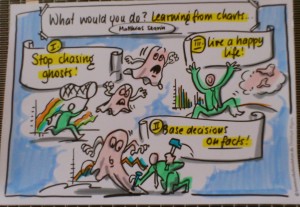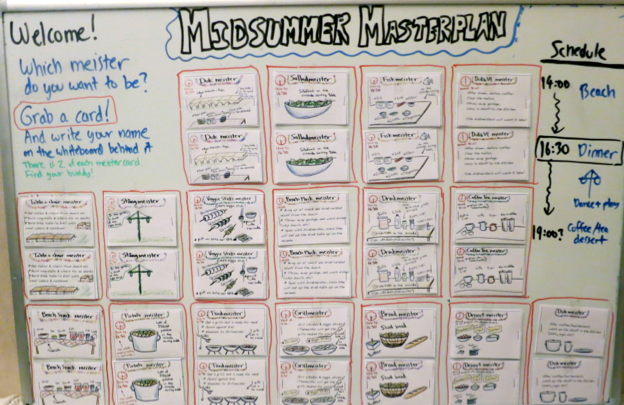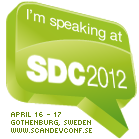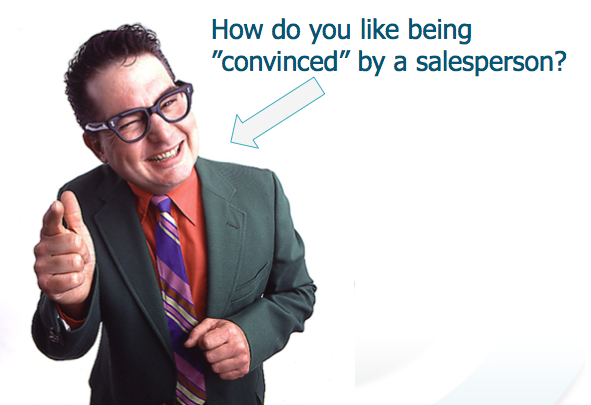Met a great crowd in Kiev at Agile Eastern Europe. I’d love to stay longer! Here are the slides on my presentation on Visualization – what’s my brain got to do with it.
Continue readingSlides from Lean Kanban France 2013
Just back from Paris (gotta love that town, many good memories there 🙂 I did my first presentation on Concepts. Here are the slides. /Mattias
Continue readingCulture > Process (Paris Scrum Gathering keynote)
Here are the slides for my keynote “Culture > Process” at the Paris Scrum Gathering. Amazing level of enthusiasm in the room, seems like this kind of stuff was exacty what people were looking for. Happy to see the ideas take such strong hold!
- Video recording part 1 (starts at 0:30)
- Video recording part 2
Bokomslag till Riv pyramiderna igen
I dagarna fick jag bokomslaget till boken Riv pyramiderna igen – Agil HR ‘from the trenches’ jag håller på att skriva på Leanpub. Jag är otroligt nöjd med det. Omslaget är gjort av Lisa Zachrisson. Så här skriver hon om tankarna bakom formgivningen: Jag tyckte att titeln skulle vara stor då det fungerar bra när
Continue readingSlides from Dare – “Visualization, what’s my brain got to do with it?”
Just got back from DARE conference in Belgium. I don’t know how Maarten makes it happen, but I always leave with more ideas than I had when I came. I ran a session on visualization – highlighting our brains limited capacity capture and record knowledge (and what to think of when using visualization). An amazingly
Continue readingIntroducing Concepts
Let me introduce a tool I’ve found useful – Concepts. Concepts is a one page specification, in A3 format that represents a product idea of feature. It is enough to enable a prepared conversation with the engineers developing the product. Think of it as a “flexible minimum specification”. The idea The concept owner is a
Continue readingStop the line presentation at SmartBear MeetUI
Sisyphus, artistry, cult of quality, weaving, broken windows and all the other stuff you have to care about if you want to build high quality software. Here’s my speech on how we did it at Atex Polopoly, held at the SmartBear MeetUI user conference May 23 2013. And here’s the slides: Build Quality In: Stop
Continue readingStop the line song
I ended my talk on the SoapUI user gathering MeetUI singing the stop the line song. Now it has ended up on youtube. Here’s the text: I keep a close watch on these tests of mine I keep my Jenkins open all the time I see a defect coming down the line Becuse you’re mine,
Continue readingStop the line as eBook
Here’s the eBook collecting my articles on building the quality in by stoping the line: Stop The Line – Why it’s crucial to include a human touch to your automated processes
Continue readingAgilt ledarskap
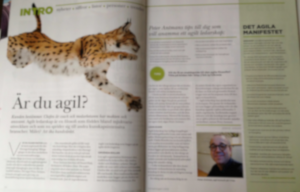 Februarinumret av tidskriften VD-tidningen har agilt ledarskap som trendspaning. Tidskriften är riktad till VD:ar och styrelseledamöter med en upplaga på runt 10 000. Den kallar sig själv “Varje VD:s bibel”. Inför numret blev jag intervjuad om min syn på agilt ledarskap.
Februarinumret av tidskriften VD-tidningen har agilt ledarskap som trendspaning. Tidskriften är riktad till VD:ar och styrelseledamöter med en upplaga på runt 10 000. Den kallar sig själv “Varje VD:s bibel”. Inför numret blev jag intervjuad om min syn på agilt ledarskap.
Eftersom texten är lite svår att komma åt bjuder jag på ett par citat från den, som inleds med ingressen:
Kunden bestämmer. Chefen är coach och medarbetaren har makten och ansvaret. Agilt ledarskap är en filosofi som föddes bland mjukvarutvecklare och som nu sprider sig till andra kunskapsintensiva branscher. Målet? Att öka kundvärdet.
Where is that Red ‘Stop’ Button in Your Development Process?
If you don’t dare to stop the line, continuous integration might be waste. Here is the second part of my three-part series on building the quality in on the SmartBear blog. In the first post of this series, I wrote about Toyoda Sakichi, the founder of the Toyota industries, who invented a loom that would
Continue readingStop the Line – Build Quality In with Incremental Compilation
We in the software industry are still far behind when it comes to automated quality checks. Toyoda Sakichi for example invented the automated loom with stop the line capability almost 100 years ago. I write more about that in my first blog in a three-part series on building the quality in on the SmartBear blog.
Continue readingAgile India slides
Agile India 2013 in Bangalore. Wow, what an awesome conference! I was amazed by the energy level of the participants, spent hours talking to people about all kinds of really interesting challenges. Based on the fully packed rooms and incredible feedback, it seems like my talks were exactly the kind of information people were looking
Continue readingAddressing critical in deliveries from subcontractors
In software, one of our favorite tool to deal with uncertainty is iterations. But is it always the better option?
The last week I’ve got the question two times of how to address critical in deliveries from subcontractors. For example: hardware, preparation of land, machinery, buildings or third party platform updates. How can these be addressed? Do iterations hold the answer? Are there better options?
Let me introduce lean flow thinking and show how it can be used to improve the outcome of critical third party in deliveries in your projects.
How to build the Right Thing
The software industry is going through a shift of mindset.
Agile basically solved the problem of how to deliver software. Most any company that applies an agile method and mindset can get working software out the door. Now, the biggest waste in software development seems to be building the wrong product, or the wrong features.
“There is surely nothing quite so useless as doing with great efficiency that which should not be done at all” -Peter Drucker
This insight has given rise to methods and techniques such as Lean Startup, Impact Mapping, Story Mapping, Feature Injection, etc. But is there a common denominator, a set of underlying principles?
On Feb 11, Gojko Adzic organized a full-day meetup in London with people deeply engaged in this issue, people like Jeff Patton, Mary Poppendieck, Ingrid Domingues, Chris Matts and others who have been inventing and spreading techniques for dealing with the how-to-build-the-right-stuff issue.
It was a very inspiring day! We compared our different approaches and experiences, extracted the core principles, and (to our surprise) managed to condense it into this shared message:
Great results happen when:
1. People know why they are doing their work.
2. Organizations focus on outcomes and impacts rather than features.
3. Teams decide what to do next based on immediate and direct feedback from the use of their work.
4. Everyone cares.
There. So now just go do it! 🙂
Actually, if you want a more detailed description of each point see Gojko’s post.
Posts from the other participants:
- Gojko Adzic – The February Revolution
- Karl Scotland – Heuristics for building the Right Thing
Lean Mindset with Mary Poppendieck, Feb 7-8
On Feb 7-8 Tom & Mary Poppendieck will be in Stockholm, we are running a workshop called “Lean Mindset“. Mary and Tom are only here 1-2 times per year, so this a good opportunity! The workshop emphasizes research, case studies and exercises. You will learn what a lean mindset is, how other companies have exposed
Continue readingHow Spotify builds products
Product development isn’t easy. In fact, most product development efforts fail, and the most common reason for failure is building the wrong product.
Spotify is a Swedish lean startup with an awesome track record of product delivery. The products are designed to be easy, personal, and fun. Even Metallica, long known as die-hard opponents to music streaming services, now say that Spotify is “by far the best streaming service” and are “stunned by the ease of it”.
Here’s the paradox though: Successful companies like Spotify only want to deliver products that people love. But they don’t know if people love it until they’ve delivered it. So how do they do it?
Check out the article “How Spotify Builds Products”
Using continuous improvement in product development
If you prefer this as an article – you can download it here.
What is continuous improvement?
Continuous improvement always starts by observing previous results. That is our baseline for improvements forward on. We strive to improve steadily, a little at a time – 10% is great! But first step is always to accept the facts, regardless if we would have liked it to be better. It is way too easy to sweep failed projects under the carpet rather than used as a baseline for improvements forward on. A mistake easily made is to base improvements on dream targets rather than previous results, it is hard to learn something from failure to meet those targets.
Lean from the Trenches @ Øredev
Here are the slides for my talk “Lean from the Trenches” at Øredev, Malmö. And here is the book/ebook, in case you want more details. There may also be some copies left at the conference bookstore. Thanks for attending!
Continue readingAgile Product Ownership in a nutshell
This is basically a 1 day product ownership course compressed into a 15 minute animated presentation.
Over a million views! Some call it “The best 15 minutes on the Internet” 🙂
There’s obviously more to product ownership than this, so see this is a high level summary.
- Here’s the complete drawing (.png format)
- Here’s a downloadable version of the video, in case you don’t want to stream (.mov format, 90 Mb)
Special thanks to Alistair Cockburn, Tom & Mary Poppendieck, Jeff Patton, Ron Jeffries, Jeff Sutherland, and Michael Dubakov for providing many of the models, metaphors, and ideas that I use in this presentation.
Translations: (see also the translation guide by Cédric Chevalerias)
- Chinese – simplified (subtitles)
- Chinese – traditional (subtitles)
- French(subtitles)
- French (voice)
- German (subtitles)
- German(voice)
- Italian (voice)
- Japanese (subtitles)
- Polish (voice)
- Portuguese – Portugal (voice)
- Portuguese – Brazil (voice)
- Russian (voice)
- Spanish (subtitles)
Below is a full transcript in english. But I recommend watching the video instead of reading the transcript. The video is 100% visual, the transcript is 0% visual…
Slides from Lean & Kanban Central Europe 2012
Hi! Just back from a great conference – LKCE 2012 – and a great town – Vienna. A really cool thing was the illustrator who worked around the clock to visualize how he interpreted the difference presentations. He did a great job (see below). What would you do – learning from charts I challenge the
Continue readingLean from the Trenches keynote @ AgileEE, Kiev
Here are the slides for my keynote “Lean from the Trenches” at Agile Eastern Europe, Kiev. And here is the book/ebook, in case you want more details. Thanks for attending!
Continue readingEverybody wants Change – but nobody likes to Be Changed
Here are the slides from my Ale2012 keynote: Everybody wants Change – but nobody likes to Be Changed.
Thanks for coming!
Light-weight problem solving template
Here’s my default approach to problem solving and organizational change. Basically a light-weight version of the A3 problem solving approach and Toyota Kata.
(BTW my keynote at ALE2012 next week is on a similar topic: “Everybody wants Change, but nobody likes to Be Changed”)
Lean from the Trenches @ Agile2012, Dallas
Here are the slides for my talk “Lean from the Trenches” at Agile2012. And here is the book/ebook, in case you want more details (unfortunately sold out in the conference bookstore). Thanks for attending!
Continue readingR3 – den agila formeln
För ett halvt decennium sedan när jag skulle börja som utvecklingschef på Polopoly kände jag att jag behövde ett verktyg som hjälpte mig att sammanfatta andemeningen och de praktiska konsekvenserna av Agile, Scrum, XP och Lean. Var och en av dessa innehåller en rad – i viss mån överlappande – begrep, som är tydliga och om man kan dem inte så svåra att förklara – om man har många timmar på sig. Men hur minns man hela denna komplexa väv? Hur kan man uttrycka den enkelt, snabbt och koncist?
Self-organizing a 50 person party
Sunshine. Over 35 adults and 15 kids milling about, playing and socializing. Some down by the beach eating snacks and windsurfing. Work going on in the background: Pototoes being boiled, tables being set, drinks brought out, BBQ lit. Nobody is giving orders, things are just happening. Looks rather chaotic. But then at 16:30, precisely on
Continue readingSlides from SDC2012 – Modern product development principles
Just finished my session at SDC 2012 where I’m arguing for less hierarchy and economically aligned decision rules that enables local teams to do tradeoffs. Mary Poppendieck commented it as “traditional product management”. Maybe that’s where we are heading 🙂 Anyway, here are the slides
Continue readingMake it possible; change your statement into a question
Not long ago I met with a manager who during a discussion ruled out the possibility of success of a solution. I was a bit surprised and afterwards asked why that was not doable. It turned out one of the reasons was the managers fear the team would kick off with unrealistic expectations and leave
Continue readingTokyo Scrum Gathering keynote: Everybody wants Change, but nobody likes to Be Changed
Here are the slides for my Tokyo Scrum Gathering keynote “Everybody wants Change, but nobody likes to be changed“. Thanks for attending! Sample slides:
Continue reading
